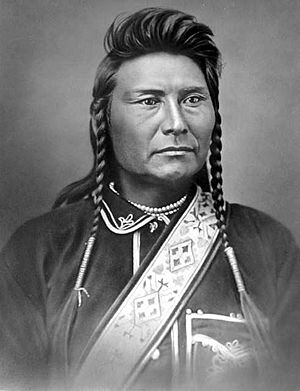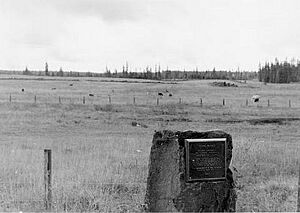Battle of the Clearwater facts for kids
Quick facts for kids Battle of the Clearwater |
|||||||
|---|---|---|---|---|---|---|---|
| Part of the Nez Perce War | |||||||
|
|||||||
| Belligerents | |||||||
| United States Army and civilian volunteers |
Nez Perce Native American tribe |
||||||
| Commanders and leaders | |||||||
| Oliver Otis Howard | Chief Joseph Looking Glass Toohoolhoolzote |
||||||
| Strength | |||||||
| 440 soldiers, about 160 civilian volunteers and Indian scouts | 200 warriors | ||||||
| Casualties and losses | |||||||
| 15 dead, 25 wounded soldiers 2 dead, 1 wounded civilians |
4 dead, 6 wounded | ||||||
The Battle of the Clearwater happened on July 11–12, 1877, in what was then the Idaho Territory. It was a major fight during the Nez Perce War. In this battle, the United States Army, led by General Oliver Otis Howard, fought against the Nez Perce tribe, whose leaders included Chief Joseph, Looking Glass, and Toohoolhoolzote.
The U.S. Army surprised a Nez Perce village. However, the Nez Perce fought back strongly, causing many injuries to the soldiers. Even though they fought bravely, the Nez Perce had to leave their village. After the battle, they moved east, crossing the Bitterroot Mountains into Montana Territory, with General Howard's army following them.
Why the Battle Happened
After White Bird Canyon
The Nez Perce had already defeated the U.S. Army at the Battle of White Bird Canyon on June 17. After this, General Oliver Otis Howard took charge of the army himself. He sent a small group to capture Looking Glass, a Nez Perce leader who was trying to stay neutral. But Looking Glass and his people escaped and joined Chief Joseph.
The Nez Perce Journey
With General Howard's army behind them, Chief Joseph and about 600 Nez Perce people, along with over 2,000 of their animals, continued their journey. They easily passed a small U.S. military group at the Battle of Cottonwood (July 3–5). They kept moving east for about 25 miles (40 km). Along the way, they took back many ranches and farms. These lands were part of the Nez Perce Reservation, and the Nez Perce believed the settlers were there illegally. The settlers had already left for nearby Mount Idaho.
Setting Up Camp
The Nez Perce set up a camp in a deep valley by the South Fork of the Clearwater River. This was north of where Stites is today. On July 7, Looking Glass and his followers joined them. This brought their total number to about 800 people, with 200 warriors ready to fight.
Volunteers and Howard's Approach
On July 8, a group of 75 civilian volunteers, led by Edward McConville, found the Nez Perce camp. They reported its location to General Howard. The Nez Perce found the volunteers the next morning and attacked them. The volunteers had to hide on a hilltop, which they called "Fort Misery." They ran out of water, and their horses were taken by the Nez Perce. One Nez Perce warrior was injured. Around noon on July 11, the volunteers left their hill and went back to Mount Idaho without any more fighting.
The Nez Perce expected General Howard and his soldiers to arrive from the northeast, the same direction the volunteers came from. But Howard approached from the south. He followed the east bank of the South Fork of the Clearwater River through rough land. Around noon on July 11, Howard saw the Nez Perce village, which was spread out on both sides of the Clearwater River. The Nez Perce were surprised because they didn't expect him to come from that direction.
Forces Involved
General Howard had about 440 soldiers. He also had around 160 civilian helpers, scouts, messengers, and Native American scouts. This meant his total force was likely more than 600 men. Some of the Native American scouts were Nez Perce who had chosen not to join Chief Joseph and remained friendly with the U.S. Army. The Nez Perce had about 200 warriors ready to fight.
The Battle Begins

General Howard started the battle by firing large cannons called howitzers and fast-firing Gatling guns. He shot at the Nez Perce camp in the valley below from the high ridge where his army was. These shots warned the Nez Perce that the soldiers were there. People and horses scattered, and the older Nez Perce, women, and children quickly moved their animals into the hills behind the camp.
Nez Perce Defense
An old warrior named Toohoolhoolzote, along with 24 other Nez Perce, including Yellow Wolf, rode to the top of the ridge. They built a small stone fort and began shooting at the soldiers. This stopped Howard's cavalry from moving forward. Soon, they were almost surrounded, so they went back to the village. Toohoolhoolzote's quick action gave other Nez Perce time to set up strong defense positions. They built these defenses around three sides of a flat area, about 1.5 miles (2.4 km) wide and 2 miles (3.2 km) long, above the east side of the Clearwater River.
About 100 Nez Perce warriors faced Howard's advancing army on this flat area. A reporter at the time said, "Even though we had more soldiers than the Indians, we fought at a big disadvantage. The Native Americans were in a protected canyon, while our men had to attack them across an open field with no trees." There was heavy fighting all afternoon. The day ended with both sides holding their fortified lines. The soldiers spent the night hungry and thirsty. The Nez Perce warriors on the battle line were supplied with food and water by the women from their village behind them.
Howard's Attack
On the morning of July 12, Howard's entire army faced the Nez Perce on the flat prairie. Howard's men managed to push the Nez Perce away from a spring, which allowed the soldiers to get water and food. Howard then planned a big attack on the Nez Perce's left side, led by Captain Marcus Miller and his group.
Suddenly, a group of 120 mules carrying supplies for Howard's army appeared on the battlefield. Captain Miller moved forward to protect these supplies. Taking advantage of his advanced position, he suddenly ordered his men to charge the Nez Perce. The Nez Perce began to retreat. Soon, they were running away as Howard's soldiers moved forward along their entire line and into the village near the river. The Nez Perce warriors crossed the Clearwater River with their women, children, and as many of their belongings as they could carry. Howard decided not to chase them further across the river. The battle was over.
After the Battle
Howard's Pursuit and Surrender Offer
The day after the battle, General Howard chased the Nez Perce about 12 miles (19 km) north to the village of Kamiah. There, he saw the Nez Perce crossing the Clearwater River. Howard quickly moved his soldiers forward, but it was too late. One cavalry soldier was injured. On July 15, Howard received a surprising message: Chief Joseph and his group wanted to surrender. However, other leaders like Looking Glass, White Bird, and Toohoolhoolzote planned to keep moving east.
Chief Joseph did not appear the next day to surrender. But 35 Nez Perce, including 14 men, did surrender. This made the army think that the Nez Perce fighting force was breaking apart. Howard learned that the Nez Perce had moved their camp to Weippe Prairie, about 15 miles (24 km) from his position. He set off to find them. The Nez Perce called Howard "General-Day-After-Tomorrow" because he moved so slowly and carefully.
Nez Perce Leadership Decisions
The Nez Perce seemed to have a difficult time making decisions about their leadership during and after the Clearwater battle. Chief Joseph was not the only leader. There were five different groups and five leaders among the Nez Perce. Each warrior also had the right to decide if and when they wanted to fight. Chief Joseph (and his brother Ollokot) likely argued against leaving Idaho and their traditional lands. However, White Bird, Looking Glass, and Toohoolhoolzote convinced the others. The Nez Perce decided to follow the difficult Lolo Trail to Lolo Pass and into Montana. Looking Glass had many friends in Montana and believed they would be safe there. He might not have understood that Idaho and Montana were both part of the same country.
Historical Connection
It's interesting to note that 72 years earlier, the Nez Perce had welcomed the hungry Lewis and Clark Expedition on Weippe Prairie. It was said that Clark had a son with a Nez Perce wife, and that son, now an old man, was with Chief Joseph's group.

Continuing the Journey
Hearing that the Nez Perce were leaving Weippe Prairie, Howard sent a strong group from Kamiah on July 17. Their job was to find out which way the Nez Perce were going. Major Edwin C. Mason and "Colonel" Edward McConville, a civilian volunteer, led this group of cavalry, civilian volunteers, and several Nez Perce scouts. Chief Joseph's Nez Perce warriors ambushed the scouts, killing two and injuring one. Mason turned back, but he had learned that the Nez Perce were traveling the Lolo Trail. The Nez Perce carried out one last raid in Idaho on July 18, stealing several hundred horses at Kamiah.
On July 16, the main group of Nez Perce left Weippe Prairie. They began their tough journey on the Lolo Trail, which was 120 miles (200 km) through uninhabited mountains. There were about 750 people in total, with two thousand horses and hundreds of dogs. Their column stretched for several miles. They appeared on the Montana side of the Lolo Pass on July 25, having completed the difficult trip quite easily. Soon, they would meet the U.S. army again. Howard, with 700 men, started after the Nez Perce on the Lolo Trail on July 30. He sent messages ahead, and soldiers waited for the Nez Perce just over the Montana border at Fort Fizzle. Colonel John Gibbon would then try to stop the Nez Perce at the Battle of the Big Hole.

